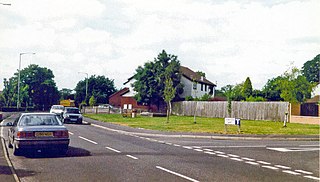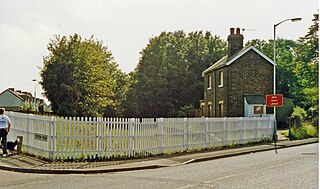Related Research Articles

Gosport is a town and non-metropolitan borough, on the south coast of Hampshire, South East England. At the 2021 Census, its population was 81,952. Gosport is situated on a peninsula on the western side of Portsmouth Harbour, opposite the city of Portsmouth, to which it is linked by the Gosport Ferry. Gosport lies south-east of Fareham, to which it is linked by a Bus Rapid Transit route and the A32. Until the last quarter of the 20th century, Gosport was a major naval town associated with the defence and supply infrastructure of His Majesty's Naval Base (HMNB) Portsmouth. As such over the years extensive fortifications were created.
Cockerham Cross railway station, also known as Cockerham Crossing railway station was a halt at a level crossing on a road that crossed Cockerham Moss towards Cockerham in Lancashire, England. It opened with the line in 1870 and closed in 1930.

Nateby railway station served the village Nateby in Lancashire, England. It was originally named Winmarleigh railway station after the landowner at that time and was renamed after his death in 1902. Originally only a halt with the platform on the southern side of the line, it received a passing loop in 1909 and a second platform on the northern side, and by 1910 it also had a goods siding with a cattle dock. Passenger services were withdrawn in 1930, and the station closed altogether in 1950.

Garstang Town railway station served the market town of Garstang in Lancashire, England. It opened in 1870. The station closed for passengers in 1930 and for freight in 1965.

Privett station was an intermediate station on the Meon Valley line which ran from Alton to Fareham during the first half of the 20th century. Named after the hamlet of Privett, the station was in fact over half a mile from its namesake and was built in largely uninhabited countryside.

Kew Gardens was a railway station at Kew on the edge of Southport, Merseyside, England, situated north of the A570 between Meols Cop Road and Foul Lane.
The Gosport and Cosham lines were a collection of railway lines in southern Hampshire. Most of the lines are now closed but some elements are still in use, forming part of the West Coastway line. The lines originally linked to the main London to Southampton line via the Eastleigh–Fareham line and subsequently with a line from Southampton via Bursledon, both of which are still in use.
Elrington Halt station is a closed stone built railway station situated on a single track branch railway line in Northumberland, England, that ran from Allendale through the Border Counties Junction to Hexham
The Lee-on-the-Solent Line was a three mile long railway in Hampshire, England; it was built by the Lee-on-the-Solent Railway company, promoted in association with a landowner's wish to develop a new seaside resort on his land.
The Tarleton branch was a 1.25 miles (2.01 km) long single track branch railway line in Lancashire, England, that ran from Hesketh Bank on the West Lancashire Railway to Tarleton Halt via one intermediate station, Boat Yard Crossing Halt.
New Biggin or Newbiggin was a railway station which served the village of Newbiggin near Kirkby Thore in Newbiggin parish, Cumbria, England. It was located on the Settle-Carlisle Line, 24+3⁄4 miles (39.8 km) south of Carlisle. Whilst the station is now disused, the line is still operational and the nearest open station is Appleby.

Billinge Green Halt railway station was located in Davenham, Cheshire, England. The station was opened by the London and North Western Railway on 1 October 1914, the station closed on 2 March 1942.

Fort Brockhurst railway station served the town of Gosport, Hampshire, England from 1865 to 1953 on the Fareham-Gosport line.

Edlingham railway station served the village of Edlingham, Northumberland, England from 1887 to 1953 on the Cornhill Branch.
Elmore Halt railway station served the suburbs of Lee-on-Solent, Hampshire, England from 1910 to 1930 on the Lee-on-the-Solent Railway.
Browndown Halt railway station served the town of Gosport, Hampshire, England from 1894 to 1930 on the Lee-on-the-Solent Railway.
Lee-on-the-Solent railway station served the district of Lee-on-the-Solent, Hampshire, England from 1894 to 1935 on the Lee-on-Solent Line.
Martell Bridge Halt railway station served the village of Little Newcastle, Pembrokeshire, Wales, from 1930 to 1937 on the North Pembrokeshire and Fishguard Railway.
Garstang Road railway station served the hamlet of Stake Pool, Lancashire, England, from 1923 to 1930 on the Knott End branch of the London, Midland and Scottish Railway.
Cogie Hill railway station, also known as Cogie Hill Halt railway station and Cogie Hill Crossing railway station served the village of Winmarleigh, Lancashire, England, from 1870 to 1930 on the Garstang and Knot-End Railway.
References
- ↑ Quick, M E (2002). Railway passenger stations in England, Scotland and Wales - a chronology. Richmond: Railway and Canal Historical Society. p. 187. OCLC 931112387.
- ↑ "Disused Stations: Fort Gomer Halt". Disused Stations. Retrieved 7 April 2018.